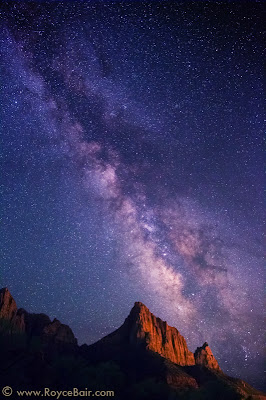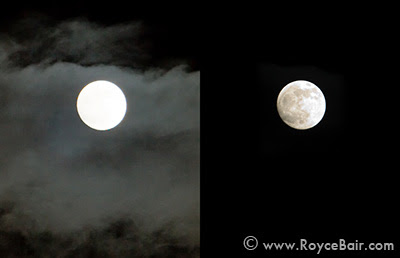Canon EF 24mm f/1.4 L II USM
During my film days, my favorite landscape lens was a 24mm f/2.8 prime lens. Those who are familiar with my recent
NightScape work know that in order to maintain the stars as points of light, you need a fast lens in conjunction with high ISO's, so that you can maintain exposures that are less than 30 seconds --otherwise you blur the stars (producing star trails). I rarely stop down to greater than f/3.5, and prefer f/2.8 where possible, which is wide-open for most prime lenses, and the better zoom lenses.
The problem with shooting a lens wide open is that stars can really show off the faults or aberrations of a lens, especially coma. Comatic aberration causes point sources, such as stars, to appear distorted --appearing to have a tail (coma) like a comet. These coma "tails" are most apparent near the edges of a photo. The good news, is that 50% of the distortion goes away when a well-designed lens is stopped down by one stop, and about 80% goes away by two stops. Unfortunately, with my night photography, I can't afford the light loss that comes with stopping down from f/2.8 to f/4.0 or f/5.6!
This is the reason I purchased the Canon 24mm f/1.4 lens. As you can see from my own tests on point sources of light, this lens is fairly well-corrected by f/2.8 (click on any image for a larger view):
And, if I get in a pinch, and need more light, it produces acceptable results at f/2.0. But the real beauty of this lens is the bright image it gives you in the viewfinder. You can imagine that composing in near pitch black is made so much easier with this brilliant, f/1.4 lens! Here's a recent Milky Way photo I took with it in Zion National Park at 4:00 in the morning. The amber glow on The Watchman is coming from the lights of Springdale city!
Technical info: Canon EOS 5D Mark III, using the Canon EF 24mm F/1.4L II lens @ F/2.8, 15 seconds, ISO 8000 (click on any image for a larger view):
Although this lens is designed for full-frame sensors, I find a lot of use for it as a candid portrait lens on APS-C size sensor cameras, i.e. my Canon 7D. On these smaller sensors, the lens performs similar to a 35mm lens (going from an 84º angle of view to about 63º). Shooting wide open is awesome! You focus on the eyes of an active child, and the back of their head is already out of focus, with the background an un-distracting blur. This same thing applies to close-up nature photography, like these blue flax wildflowers I photographed at f/2.8:
Canon EF 15mm f/2.8 Fisheye
This fisheye lens is my favorite night photography lens because it allows me to include more than twice the sky as my 24mm lens (180º vs. 84º), and because it's really two lenses in one. Although the heavy barrel distortion from this 15mm fisheye lens creates a special effect that is liked by most people, I can remove that distortion with software if I choose, giving me a view somewhat similar to Canon's EF 14mm f/2.8L II USM lens, which has a fairly undistorted 114º angle of view. Here's an example of what I mean. Below, is another shot of The Watchman and the Milky Way, taken from the foothills west of Springdale, Utah at 2:00 in the morning (light pollution from the city is lighting The Watchman). This is 15mm fisheye view without any distortion correction.
Technical info: Canon EOS 5D Mark III camera, using the Canon EF 15mm F/2.8 Fisheye lens @ F/3.5, 30 seconds, ISO 6400.
In the next image, I left the barrel distortion alone on the left side, but did a partial correction on the right side using Photoshop's "Edit > Transform > Warp" function:
Although a more complete distortion correction could have been accomplished with software, i.e. DxO Labs, I've found this is not always as aesthetically pleasing as being more selective via Photoshop. I should point out that this lens has fairly acceptable coma at its wide-open aperture of F/2.8; it about 65% corrected at F/3.5, and it is about 75% corrected at F/4.0.
Un-warping your own images: Would you be interested in learning how to "un-warp" your own images? Images from any lens can benefit from de-warping, not just fisheyes. Take this
quick poll (your anonymous answers will determine whether I add this topic to a future blog or newsletter).
For other tips and tutorials, you can
subscribe to my newsletter.

















